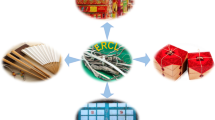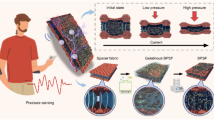Abstract
Printing technology for electronic devices has garnered considerable attention owing to its rapid and massive productivity under ambient conditions. In this study, a facile approach is proposed for manufacturing cellulose paper-based strain sensors with Ni/multi-walled carbon nanotube (MWCNT) composites using roll stam** technology. This process enables the fabrication of stable sensing structures owing to the formation of stable Ni core-envelo** structures in the MWCNT interlacing network. In particular, the rheological properties of the composites revealed shear thinning and thixotropic behavior, which resulted in fine printing of the sensing electrodes. Furthermore, the shape of the printed patterns, imparted by the pattern morphology, significantly influenced the strain-sensing performance. In particular, the Ni/MWCNT composite-based strain sensor exhibited a higher gauge factor of 13.9, with a high sensing recovery of 90.4% and stability over 23,500 bending cycles.





Similar content being viewed by others
Availability of data and materials
The authors confirm that data supporting the findings of this study are available within the article.
References
Bolton W (2021) Chapter 2: instrumentation system elements. In: Bolton WBT (ed) Instrumentation and control systems, 1st edn. Newnes, London, pp 17–70
Bu Y, Shen T, Yang W, Yang S, Zhao Y, Liu H, Zheng Y, Liu C, Shen C (2021) Ultrasensitive strain sensor based on superhydrophobic microcracked conductive Ti3C2Tx MXene/paper for human-motion monitoring and E-skin. Sci Bull 66:1849–1857. https://doi.org/10.1016/j.scib.2021.04.041
Capelson M, Hetzer MW (2009) Development and disease. Mol Biol 15:1–9. https://doi.org/10.1038/embor.2009.147
Desai AV, Haque MA (2007) Mechanical properties of ZnO nanowires. Sens Actuators A Phys 134:169–176. https://doi.org/10.1016/j.sna.2006.04.046
Duan Z, Jiang Y, Huang Q, Zhao Q, Yuan Z, Zhang Y, Wang S, Liu B, Tai H (2021) Integrated cross-section interface engineering and surface encapsulating strategy: a high-response, waterproof, and low-cost paper-based bending strain sensor. J Mater Chem C 9:14003–14011. https://doi.org/10.1039/d1tc03031k
Falk N, Lösl M, Schröder N, Gießl A (2015) Specialized cilia in mammalian sensory systems. Cells 4:500–519. https://doi.org/10.3390/cells4030500
Freitas FS, Gonçalves AS, De Morais A, Benedetti JE, Nogueira AF (2012) Graphene-like MoS2 as a low-cost counter electrode material for dye-sensitized solar cells. J Energy Sustain. https://doi.org/10.1039/c0xx00000x
Girirajan S, Campbell C, Eichler E (2011) 乳鼠心肌提取 HHS public access. Physiol Behav 176:139–148. https://doi.org/10.1111/febs.14068.Intraflagellar
Gong S, Lai DTH, Su B, Si KJ, Ma Z, Yap LW, Guo P, Cheng W (2015) Highly stretchy black gold E-Skin nanopatches as highly sensitive wearable biomedical sensors. Adv Electron Mater 1:1–7. https://doi.org/10.1002/aelm.201400063
Hwang B, Han Y, Matteini P (2022) Bending fatigue behavior of Ag nanowire/Cu thin-film hybrid interconnects for wearable electronics. Facta Univ Ser Mech Eng. https://doi.org/10.22190/FUME220730040H
Jenkins K, Yang R (2017) Mechanical transfer of ZnO nanowires for a flexible and conformal piezotronic strain sensor. Semicond Sci Technol 32:74004–74004
Jiang D, Wang Y, Li B, Sun C, Wu Z, Yan H, **ng L, Qi S, Li Y, Liu H, **e W, Wang X, Ding T, Guo Z (2019) Flexible sandwich structural strain sensor based on silver nanowires decorated with self-healing substrate. Macromol Mater Eng 304:1–9. https://doi.org/10.1002/mame.201900074
Kamkar M, Nourin Sultana SM, Patangrao Pawar S, Eshraghian A, Erfanian E, Sundararaj U (2020) The key role of processing in tuning nonlinear viscoelastic properties and microwave absorption in CNT-based polymer nanocomposites. Mater Today Commun 24:101010–101010. https://doi.org/10.1016/j.mtcomm.2020.101010
Lan S, Lee H, Ni J, Lee S, Lee M (2008) Survey on roller-type nanoimprint lithography (RNIL) process. Paper presented at the 2008 international conference on smart manufacturing application
Lan S, Song JH, Lee MG, Ni J, Lee NK, Lee HJ (2010) Continuous roll-to-flat thermal imprinting process for large-area micro-pattern replication on polymer substrate. Microelectron Eng 87:2596–2601. https://doi.org/10.1016/j.mee.2010.07.021
Lee DJ, Kim DY (2019) Paper-based, hand-painted strain sensor based on ITO nanoparticle channels for human motion monitoring. IEEE Access 7:77200–77207. https://doi.org/10.1109/ACCESS.2019.2920920
Li Y, Gan G, Huang Y, Yu X, Cheng J, Liu C (2019) Ag-NPs/MWCNT composite-modified silver-epoxy paste with improved thermal conductivity. RSC Adv 9:20663–20669. https://doi.org/10.1039/c9ra03090e
Liao X, Zhang Z, Liao Q, Liang Q, Ou Y, Xu M, Li M, Zhang G, Zhang Y (2016) Flexible and printable paper-based strain sensors for wearable and large-area green electronics. Nanoscale 8:13025–13032. https://doi.org/10.1039/c6nr02172g
Liu L, Ye X, Wu K, Han R, Zhou Z, Cui T (2009) Humidity sensitivity of multi-walled carbon nanotube networks deposited by dielectrophoresis. Sensors 9:1714–1721
Liu H, Jiang H, Du F, Zhang D, Li Z, Zhou H (2017a) Flexible and degradable paper-based strain sensor with low cost. ACS Sustain Chem Eng 5:10538–10543. https://doi.org/10.1021/acssuschemeng.7b02540
Liu H, Qing H, Li Z, Han YL, Lin M, Yang H, Li A, Lu TJ, Li F, Xu F (2017b) Paper: a promising material for human-friendly functional wearable electronics. Mater Sci Eng R 112:1–22. https://doi.org/10.1016/j.mser.2017.01.001
Liu L, Jiao Z, Zhang J, Wang Y, Zhang C, Meng X, Jiang X, Niu S, Han Z, Ren L (2021) Bioinspired, superhydrophobic, and paper-based strain sensors for wearable and underwater applications. ACS Appl Mater Interfaces 13:1967–1978. https://doi.org/10.1021/acsami.0c18818
Mandal P, Mondal SC (2018) Investigation of electro-thermal property for Cu-MWCNT composite coating on anodized 6061 aluminium alloy. Appl Surf Sci 454:138–147. https://doi.org/10.1016/j.apsusc.2018.05.130
Mayappan R, Hassan AA, Ab Ghani NA, Yahya I, Andas J (2016) Improvement in intermetallic thickness and joint strength in carbon nanotube composite Sn–3.5Ag lead-free solder. Mater Today Proc 3:1338–1344. https://doi.org/10.1016/j.matpr.2016.04.012
Mehmood A, Mubarak NM, Khalid M, Walvekar R, Abdullah EC, Siddiqui MTH, Baloch HA, Nizamuddin S, Mazari S (2020) Graphene based nanomaterials for strain sensor application: a review. J Environ Chem Eng 8:103743–103743. https://doi.org/10.1016/j.jece.2020.103743
Najafabadi AH, Tamayol A, Annabi N, Ochoa M, Mostafalu P, Akbari M, Nikkhah M, Rahimi R, Dokmeci MR, Sonkusale S, Ziaie B, Khademhosseini A (2014) Biodegradable nanofibrous polymeric substrates for generating elastic and flexible electronics. Adv Mater 26:5823–5830. https://doi.org/10.1002/adma.201401537
Qi X, Lim S (2022) A screen-printed metal hybrid composite for wireless wind sensing. Nanomaterials 12:972
Qi X, Ha H, Hwang B, Lim S (2020a) Printability of the screen-printed strain sensor with carbon black/silver paste for sensitive wearable electronics. Appl Sci 10:1–10. https://doi.org/10.3390/app10196983
Qi X, Li X, Jo H, Sideeq Bhat K, Kim S, An J, Kang JW, Lim S (2020b) Mulberry paper-based graphene strain sensor for wearable electronics with high mechanical strength. Sens Actuators A Phys 301:111697–111697. https://doi.org/10.1016/j.sna.2019.111697
Qian Q, Wang Y, Zhang M, Chen L, Feng J, Wang Y, Zhou Y (2019) Ultrasensitive paper-based polyaniline/graphene composite strain sensor for sign language expression. Compos Sci Tech 181:107660–107660. https://doi.org/10.1016/j.compscitech.2019.05.017
Reinhardt K, Hofmann N, Eberstein M (2018) The importance of shear thinning, thixotropic and viscoelastic properties of thick film pastes to predict effects on printing performance. In: EMPC 2017: 21st European microelectronics and packaging conference & exhibition 2018-Jan, pp 1–7. https://doi.org/10.23919/EMPC.2017.8346831
Sezer HK, Eren O (2019) FDM 3D printing of MWCNT re-inforced ABS nano-composite parts with enhanced mechanical and electrical properties. J Manuf Process 37:339–347. https://doi.org/10.1016/j.jmapro.2018.12.004
Song P, Song J, Zhang Y (2020) Stretchable conductor based on carbon nanotube/carbon black silicone rubber nanocomposites with highly mechanical, electrical properties and strain sensitivity. Compos Part B Eng 191:107979–107979. https://doi.org/10.1016/j.compositesb.2020.107979
Spitalsky Z, Tasis D, Papagelis K, Galiotis C (2010) Carbon nanotube-polymer composites: chemistry, processing, mechanical and electrical properties. Prog Polym Sci 35:357–401. https://doi.org/10.1016/j.progpolymsci.2009.09.003
Tortorich RP, Shamkhalichenar H, Choi J-W (2018) Inkjet-printed and paper-based electrochemical sensors. Appl Sci 8:288
Wei Y, Chen S, Li F, Lin Y, Zhang Y, Liu L (2015) Highly stable and sensitive paper-based bending sensor using silver nanowires/layered double hydroxides hybrids. ACS Appl Mater Interfaces 7:14182–14191. https://doi.org/10.1021/acsami.5b03824
**a K, Chen X, Shen X, Li S, Yin Z, Zhang M, Liang X, Zhang Y (2019) Carbonized Chinese art paper-based high-performance wearable strain sensor for human activity monitoring. ACS Appl Electron Mater 1:2415–2421. https://doi.org/10.1021/acsaelm.9b00564
Yang L, Liu H, Zhang Y, Yu H (2017) Study on the reliability of carbon nanotube-reinforced Sn–58Bi lead-free solder joints. J Mater Eng Perform 26:6028–6036. https://doi.org/10.1007/s11665-017-3033-8
Yim YJ, Rhee KY, Park SJ (2016) Electromagnetic interference shielding effectiveness of nickel-plated MWCNTs/high-density polyethylene composites. Compos Part B Eng 98:120–125. https://doi.org/10.1016/j.compositesb.2016.04.061
Yun TG, Kim D, Kim SM, Kim ID, Hyun S, Han SM (2018) Mulberry paper-based supercapacitor exhibiting high mechanical and chemical toughness for large-scale energy storage applications. Adv Energy Mater 8:1–9. https://doi.org/10.1002/aenm.201800064
Zhao J, Guang-Yu Z, Shi D-X (2013) Review of graphene-based strain sensors. Chin Phys B 22:57701–57701. https://doi.org/10.1088/1674-1056/22/5/057701
Acknowledgments
This work was supported by a National Research Foundation of Korea (NRF) grant funded by the Korean government (NRF-2021R1A2C1011248). This research was supported by the Korea Institute for Advancement of Technology (KIAT) grant funded by the Korean Government (MOTIE) (P0002007, 2022 HRD Program for Industrial Innovation).
Funding
This work was supported by a National Research Foundation of Korea (NRF) grant funded by the Korean government (NRF-2021R1A2C1011248). This research was supported by the Korea Institute for Advancement of Technology (KIAT) grant funded by the Korean Government (MOTIE) (P0002007, 2022 HRD Program for Industrial Innovation).
Author information
Authors and Affiliations
Contributions
XQ: Conceptualization, Methodology, Data curation, Writing—original draft. PM: Investigation, Review and editing. BH: Investigation, Review and editing. SL: Supervision, Investigation, review and editing.
Corresponding authors
Ethics declarations
Competing interests
The authors declare that they have no known competing financial interests or personal relationships that could have influenced the work reported in this study.
Ethics approval and consent to participate
None.
Consent for publication
We, the undersigned, give consent for the publication of identifiable details, which can include photographs (s) and details within the text to be published in this journal.
Additional information
Publisher's Note
Springer Nature remains neutral with regard to jurisdictional claims in published maps and institutional affiliations.
Supplementary Information
Below is the link to the electronic supplementary material.
Rights and permissions
Springer Nature or its licensor (e.g. a society or other partner) holds exclusive rights to this article under a publishing agreement with the author(s) or other rightsholder(s); author self-archiving of the accepted manuscript version of this article is solely governed by the terms of such publishing agreement and applicable law.
About this article
Cite this article
Qi, X., Matteini, P., Hwang, B. et al. Roll stamped Ni/MWCNT composites for highly reliable cellulose paper-based strain sensor. Cellulose 30, 1543–1552 (2023). https://doi.org/10.1007/s10570-022-04970-3
Received:
Accepted:
Published:
Issue Date:
DOI: https://doi.org/10.1007/s10570-022-04970-3




